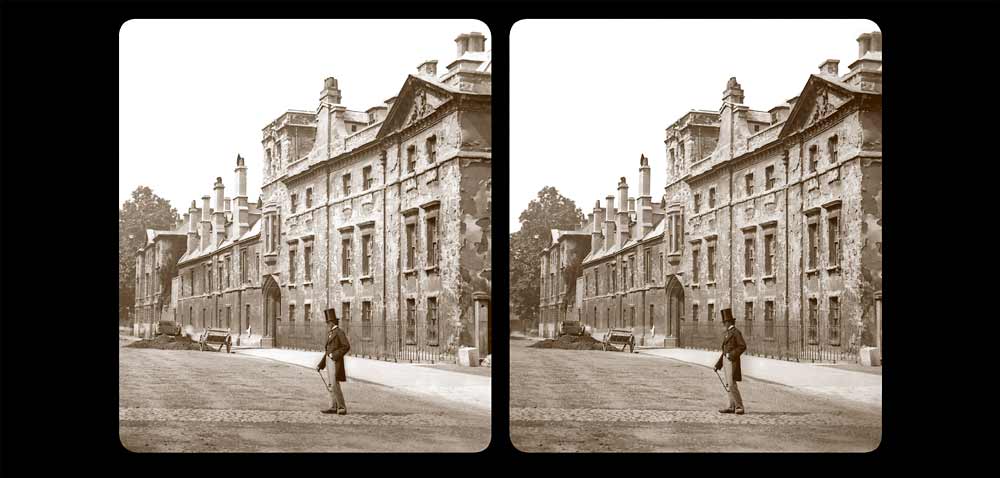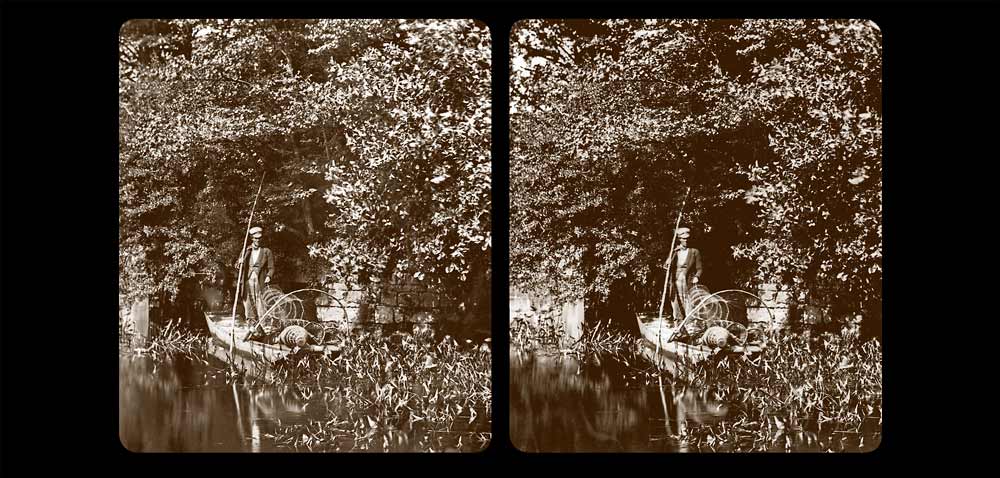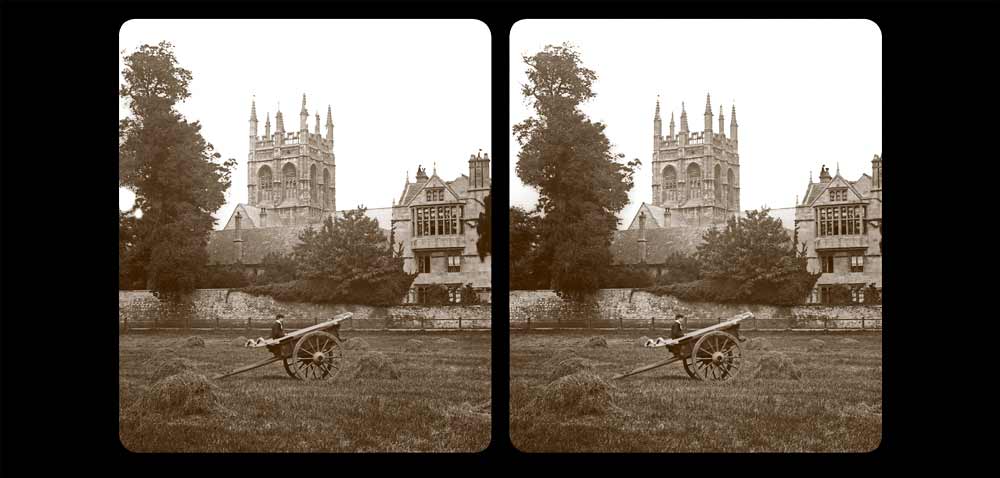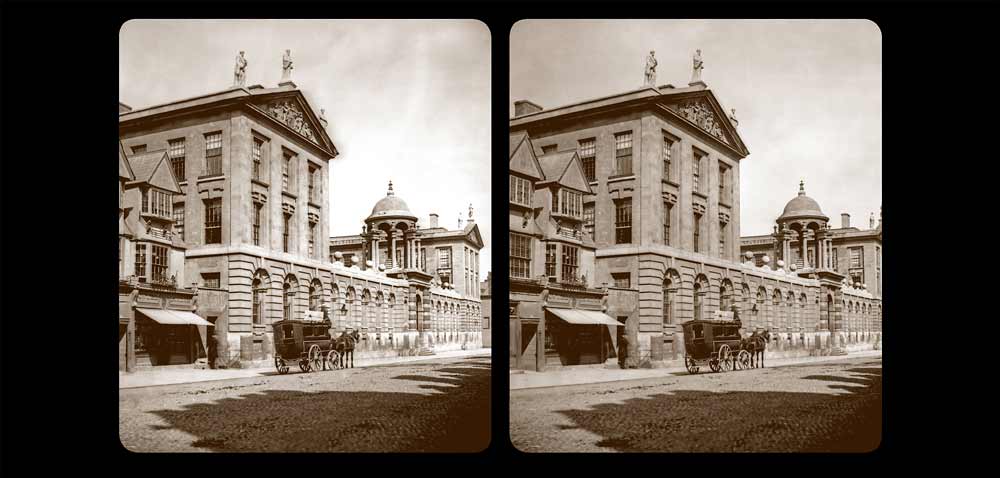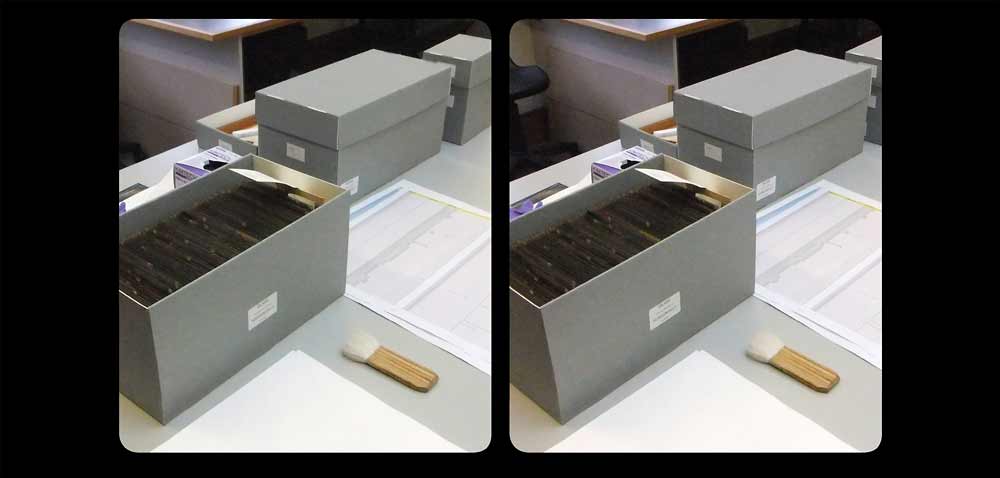
Housed in three wooden boxes at the Weston Library, Oxford, are some 170 original wet plate negatives offered the year of his death by Walter Lewis Spiers (1848-1917) one of the 13 children of Richard James Spiers (1806-1877) and his wife Elizabeth Phené, née Joy (1818-1858).
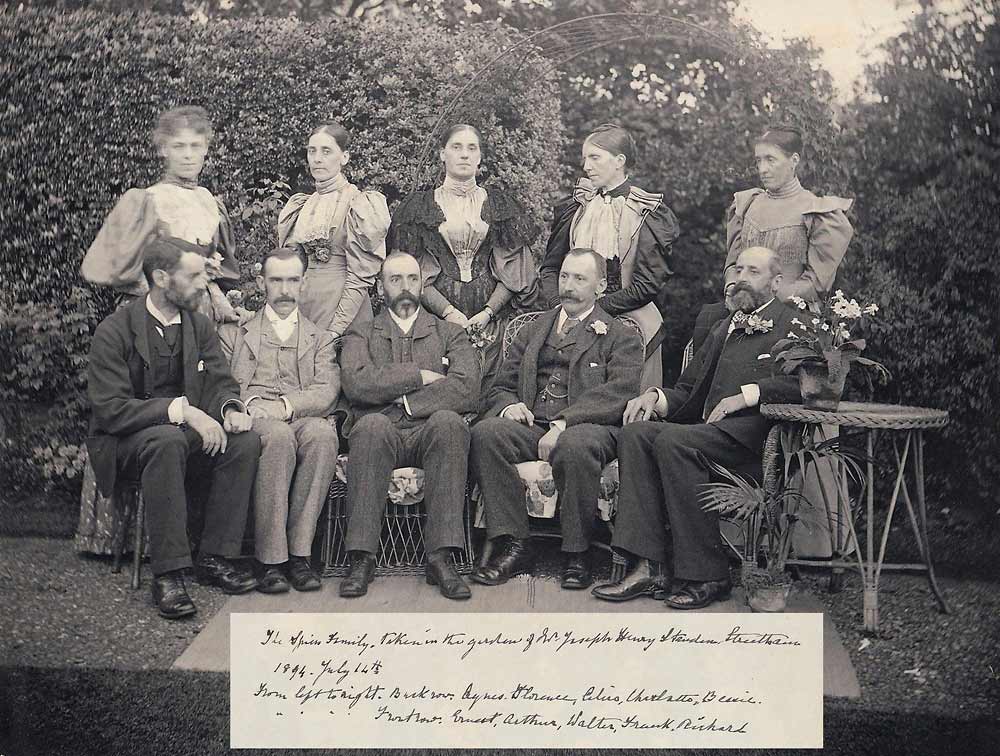
What makes these glass plates particularly interesting is that they were made between 1856 and 1858 by some of the greatest stereo photographers of the time and, for most of them, are rare examples of double stereoscopic negatives obtained with a vertical stereo camera and the Latimer Clark system.
Double stereoscopic negatives ? Vertical stereo camera ? Latimer Clark system ? What on earth is he talking about ?
Before we answer that fundamental question let’s go back in time to set the scene and introduce some of the protagonists of this fascinating story.
It all begins on 16 June 1806 with the birth in Oxford of Richard James, the eldest child of Richard Spiers, hairdresser and perfumier, and his wife Catherine, née Sirman. The boy was quickly baptized, two days after opening his eyes to the world, at the church of St. Mary the Virgin as were his siblings after him; first Ann, born in 1807, then James, born in 1809, and finally Catherine Sirman, born in 1811. On 27 June 1827, just days after he had turned 21, Richard James, like his father before him, was matriculated at the University of Oxford as a privileged person and a “tonsor” or hairdresser. He was not to remain one all his life though for, on 26 March 1834, he took possession of a shop at 102 High Street which was described the following year in the Oxford directory as a stationary and goods shop. It later became a china and glass warehouse. On 15 July 1837, Richard James Spiers, 31, married Elizabeth Phené Joy, 19, and on this occasion a poem to the bride and groom was printed on silk, which lifts any ambiguity as to the pronunciation of the groom’s name: it is Spiers, as in spires, not as in spears. Here is a an extract from this piece, signed A. C., which, for a very good reason, is absent from any anthology of poetry.
On the Marriage of Richard Spiers, Esq. to Miss Joy.
I.
In SPIERS’ breast ‘tis love in-spires
To make an earthly JOY his own;
Oh ! may no care their bliss alloy,
Or shadow ‘cross their path be thrown
For he a-SPIRES to a JOY,
And she’s a JOY to SPIERS !
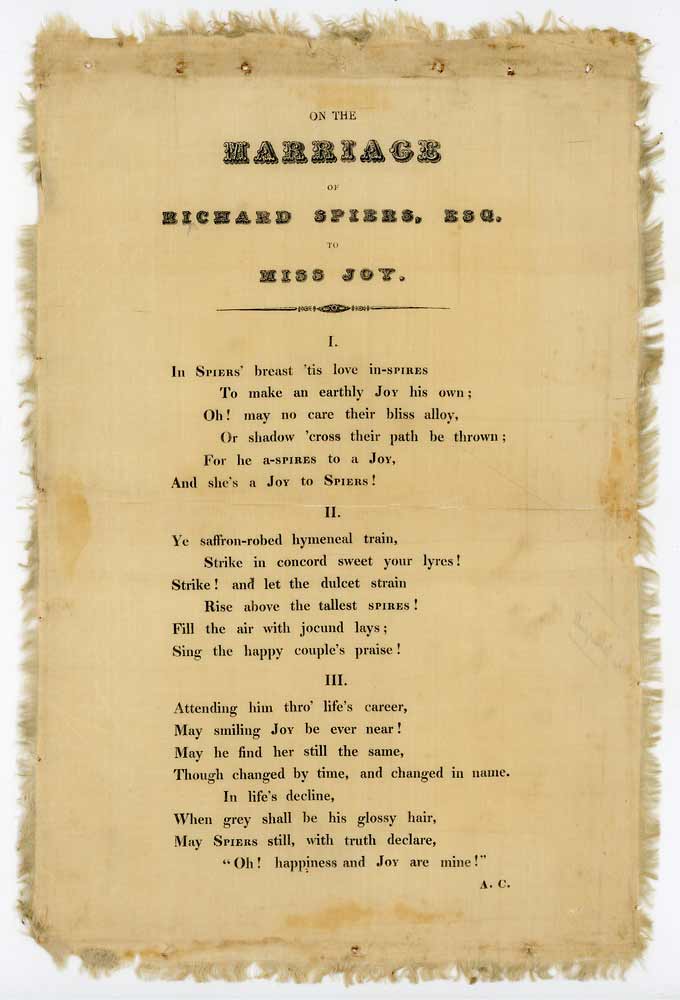
As soon as the wedding was over Spiers took his young bride on a three and a half month honeymoon and they travelled to the Isle of Wight, Belgium, Germany, Austria, Italy and Holland. It is to be hoped the bride enjoyed this extensive trip as she spent the next eighteen years being either pregnant or looking after the thirteen children the couple had between 1838 and 1856. When they got back to Oxford, the couple started living over their shop but after the birth of their second child in 1840 they moved to 19 St. John Street, where Richard James Spiers, perfumier, and his family are described by the enunciator of the 1841 census as living there with two servants. After the coming of the third child, born in 1841, the growing family moved to 14 St. Giles, in a house they were to occupy for the next 35 years. Their remaining ten children were all born there. While expanding his premises (he was soon to occupy numbers 102 and 103 High Street and had for a while a second shop at 46 Cornmarket street) and diversifying his activities (he became a manufacturer of papier mâché goods) Spiers took an interest in local affairs. He was Sheriff of Oxford in 1851-2 and Mayor in 1853-4. A woodcut published in the Illustrated London News on 1 July 1854 shows Spiers and his wife receiving the guests of a banquet in the old Town Hall.
At the Great Exhibition of 1851 the firm Spiers and Son (the son was his second born, Samuel Patey, 1840-1891) took a selection of cardboard and papier mâché goods for which they got an honourable mention. The Art Journal Illustrated Catalogue described their ware in the following way:
The contributions in papier mâché of Messrs. SPIERS & SON, of Oxford, are numerous; they consist of tables, work tables, writing-desks, tea-trays, albums, fire-screens, portfolios, &c., all of which are in good tastes; the ornamentation being sufficiently subdued, and regard being had, generally, to harmony of composition. They derive much of their interest and attraction from the paintings with which they are embellished, consisting of some of the most picturesque or celebrated edifices in Oxford, as well as sketches taken from its outskirts.1 The Art Journal Illustrated Catalogue, 1851, p. 253
At the exhibition of New York in 1853 a similar assortment was awarded a prize medal but two years later, at the Paris exhibition, it was back to an honourable mention. The shop at 102 & 103 High Street, its proprietors and its wares received unexpected publicity in 1853 when they were featured by Edward Bradley (1827-1889) – writing and illustrating his own works under the pseudonym of Cuthbert Bede – in his novel The Adventures of Mr. Verdant Green, an Oxford Freshman. Mr. Larkyns, a friend of the novel’s hero, takes him down High Street where “they stopped at the corner of Oriel Street, to look in at a spacious range of shop windows, that were crowded with a costly and glittering profusion of papier mâché articles, statuettes, bronzes, glass, and every kind of “fancy goods” that could be classed as “art-workmanship” 22. Cuthbert Bede, The Adventures of Mr. Verdant Green, an Oxford Freshman, chapter X, p. 90
Mr. Verdant Green was soon deeply engaged in an inspection of those papier-mâché “remembrances of Oxford” for which the Messrs. Spiers are so justly famed; but after turning over tables, trays, screens, desks, albums, portfolios, and other things,—all of which displayed views of Oxford from every variety of aspect, and were executed with such truth and perception of the higher qualities of art, that they formed in themselves quite a small but gratuitous Academy exhibition, — our hero became so confused among the bewildering allurements around him, as to feel quite an embarras de richesses, and to be in a state of mind in which he was nearly giving Mr. Spiers the most extensive (and expensive) order which probably that gentleman had ever received from an undergraduate. 3Ibid. p. 91
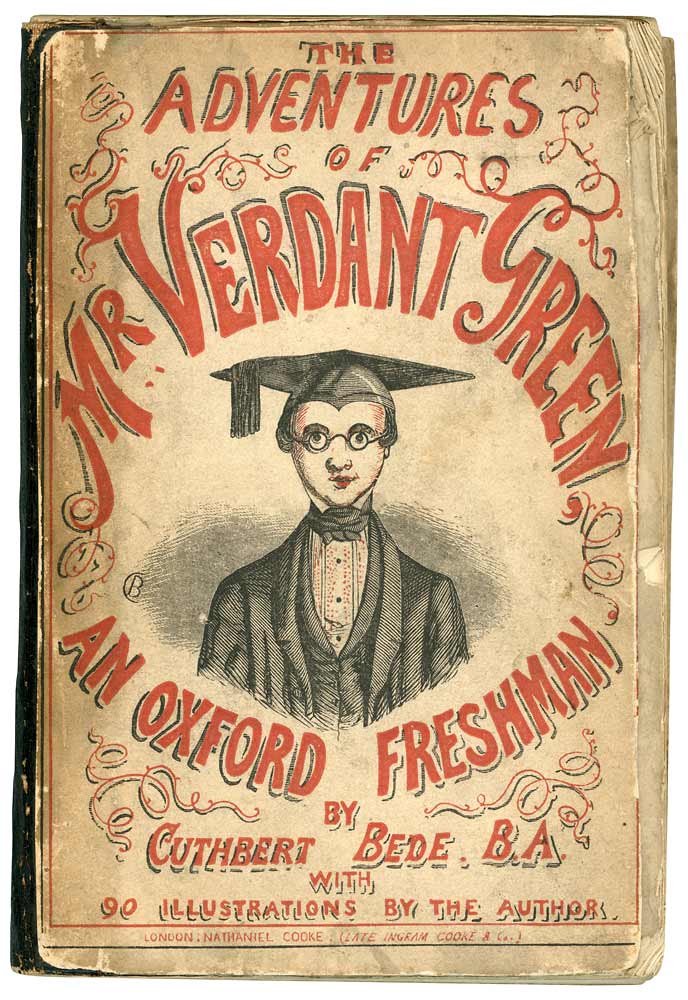
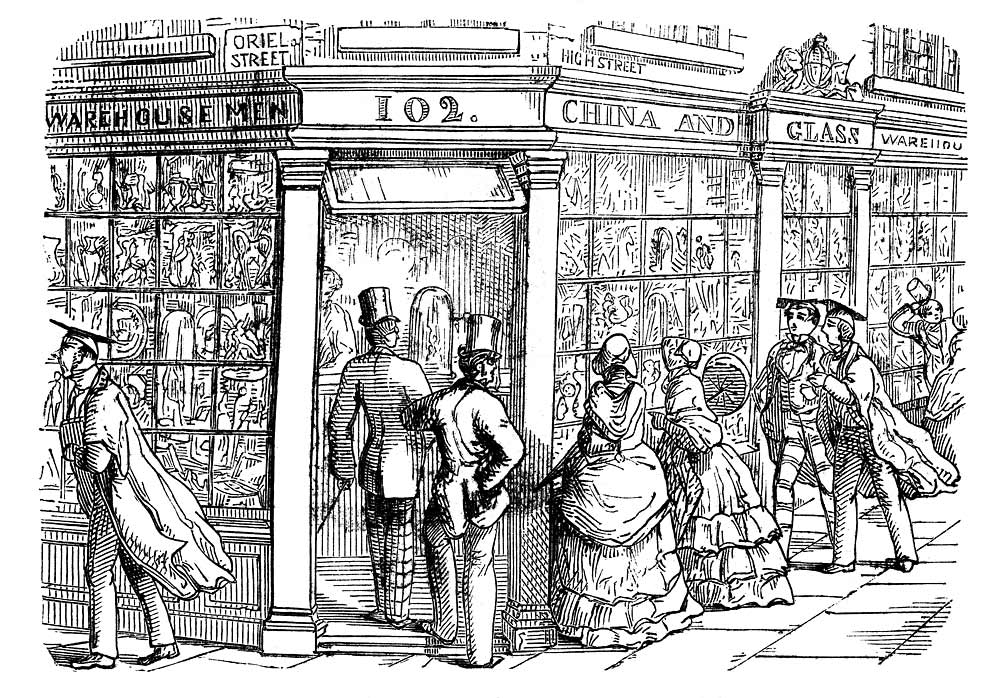
It is not very clear when Richard and/or Samuel Spiers got interested in optical toys, but an advertisement published in the Oxford Journal on 24 December 1852 shows that they were not only selling polyoramas and stereoscopes – along with playing cards, board games and large musical boxes – but also hiring them for an evening or a longer period, which makes them among the very first to provide that kind of service. Stereoscopy, which recreated the illusion of depth from two flat perspectives taken from slightly different points of view, was invented in 1832 by physicist and musical instrument maker Charles Wheatstone (1802-1875) and was officially presented to a scientific audience at a meeting of the Royal Society on 21 June 1838. This event took place one year before photography was revealed to the world both in France, with Louis Jacques Mandé Daguerre’s process on metal, and in Britain, with William Henry Fox Talbot’s on paper. Wheatstone’s stereoscope (a word he had coined and meant “I see solid”), although it was perfect for experimenting on binocular vision, was cumbersome and used large images which, in the early days of photography, were difficult and expensive to make. It never really had any commercial succes. Wheatstone had also invented a prismatic instrument which was more portable but he didn’t like it as much as his original stereoscope. The prismatic viewer was reinvented in 1849 by Sir David Brewster who, unable to find a British optician interested in his invention went to France in 1850 and showed his lenticular stereoscope to French optician Louis Jules Duboscq. The latter showed immediate enthusiasm and started manufacturing instruments as well as making daguerreotype pictures for them. The Brewster-Duboscq stereoscope was presented at the 1851 Great Exhibition and attracted the attention of some photographers who began taking stereoscopic portraits and views and quickly specialised in them. It was not, however, until the 1855 Paris exhibition, the development of Frederick Scott Archer’s collodion process on glass and the decrease in price of photographic paper and equipment that stereoscopy really took off. The images sold or hired by Spiers and Son in December 1852 would most certainly have been lithographs of whitle outlined diagrams on a dark background as the ones shown in the illustrations below.
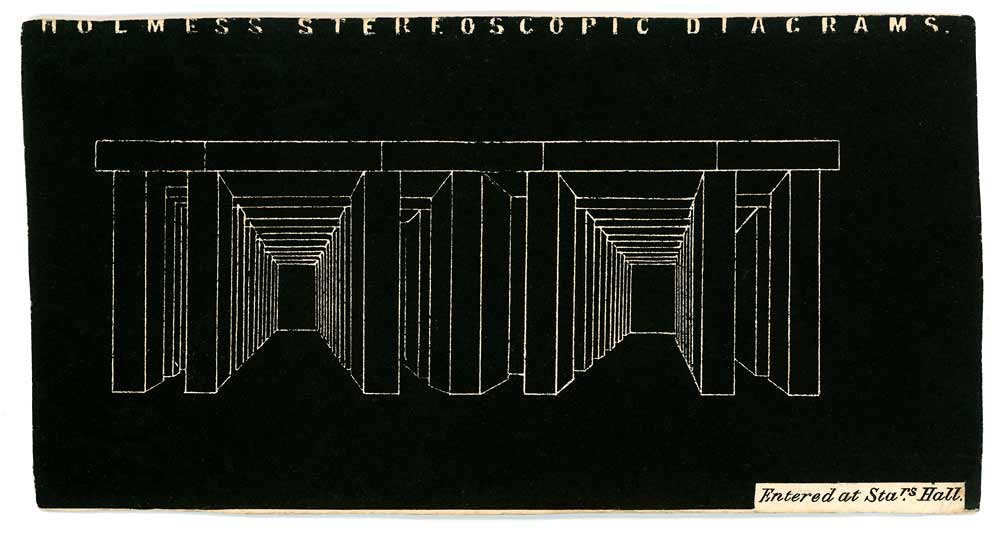
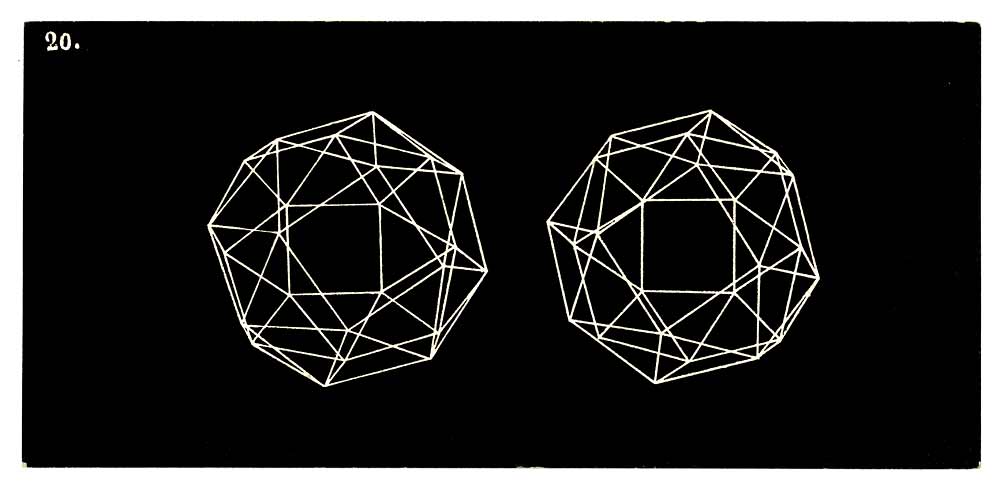
With the 1851 Exhibition over, it was decided that the temporary Crystal Palace which had housed it would be rebuilt on a more permanent basis in Sydenham. The new, bigger structure was officially opened by Queen Victoria on 10 June 1854, the stages of its construction having been faithfully recorded by artist Philip Henry Delamotte (1881-1889), official photographer to the Crystal Palace Company. In 1854, Delamotte was appointed professor of Drawing at King’s College, where Wheatsone had been professor of Experimental Philosophy since 1834, and it was the turn of Henry Negretti and Joseph Warren Zambra to get the monopoly of photography inside Sydenham Palace. They took large quantities of stereoscopic daguerreotypes and paper cards of the building and of its exhibits, one of them showing the display case of papier mâché goods manufactured by Spiers and Sons, which the latter published and sold in their Oxford shop.
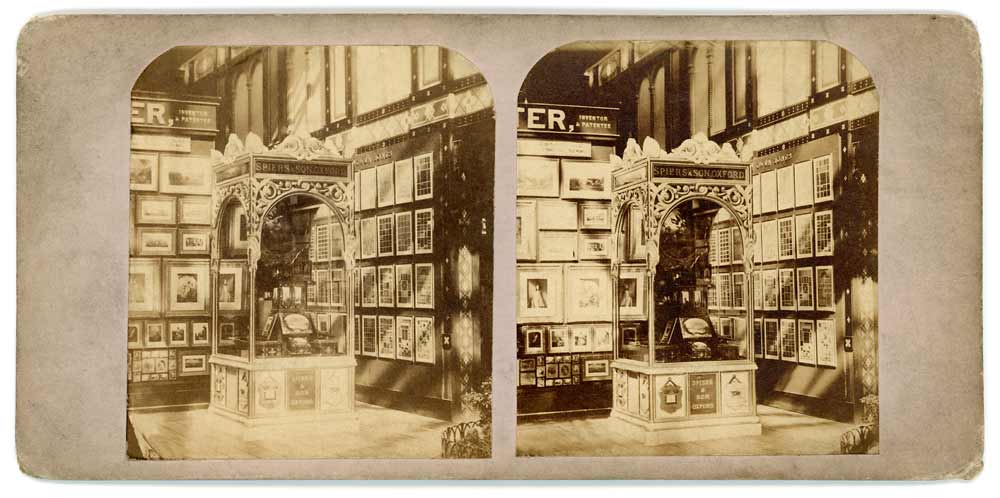
It was about the time this photo was taken, 1856, that Spiers and Son commissioned Philip Delamotte to take photographs of Oxford for the stereoscope. Delamotte, although teaching at King’s, was still into photography and the following year was to photograph in stereoscopy the perspectives of the building in which was held the Manchester Art Treasures Exhibition. Delamotte must have come to Oxford in the Spring or Summer of 1856 for, by the end of the year, the first set of images were ready to be sold. This publication was preceded by several advertisements clearly showing Spiers and Son were trying to promote their stock of viewers and slides and paving the way for their own production. Here is one of those ads, published in the Oxford Journal on 8 November 1856:
SPIERS AND SON
Have just received from the Continent a large assortment of TRANSPARENT STEREOSCOPIC SLIDES OF SWISS SCENERY, which surpass in beauty of effect any ever yet produced. Their Stock of Stereoscopes and Slides is very varied and extensive. The prices of the former are from 3s. 6d. upwards, of the Slides from 6d. to 9d. each.
A Stereoscope and 17 assorted Slides, 42s.; ditto and 27 Slides, 63s.; ditto in boxes, from 4 to 20 guineas.
Orders by post promptly attended to.
102 and 103, High-street, Oxford.
We can ascertain that Spiers and Sons were indeed selling stereoscopic ware because we have photographic evidence for it. When I started writing this article, I could not help wondering why I could not find a stereoscopic image of the shop owned by Spiers and Son. Surely that was the best way to advertise what you were selling ! While holding the LSC stall at the May 2019 edition of the Photographica fair in London, my assistant Rebecca and I were approached by a gentleman who showed us a dozen or so Spiers and Sons stereocards of Oxford that were to be auctioned a couple of months later. My heart missed a couple of beats when I saw, among them, a photo of the façade of 102-103 High Street. That was the very image I knew must exist, and a label on the back mentioned it had been taken by Philip Delamotte. I need not tell you that when the day of the auction finally came I did my utmost to win those cards for Dr. May’s collection which is how I can show you this unique image along with a close up of the shop window revealing several stereoscopes.
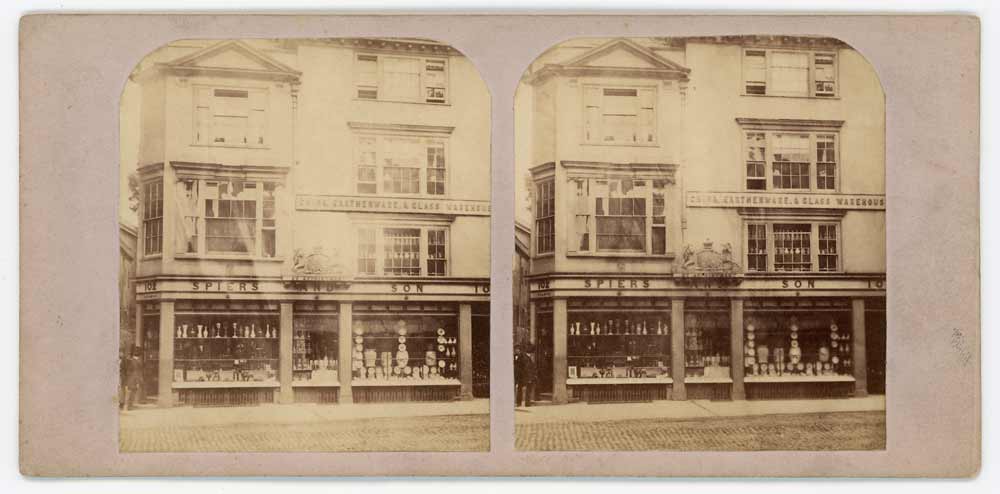
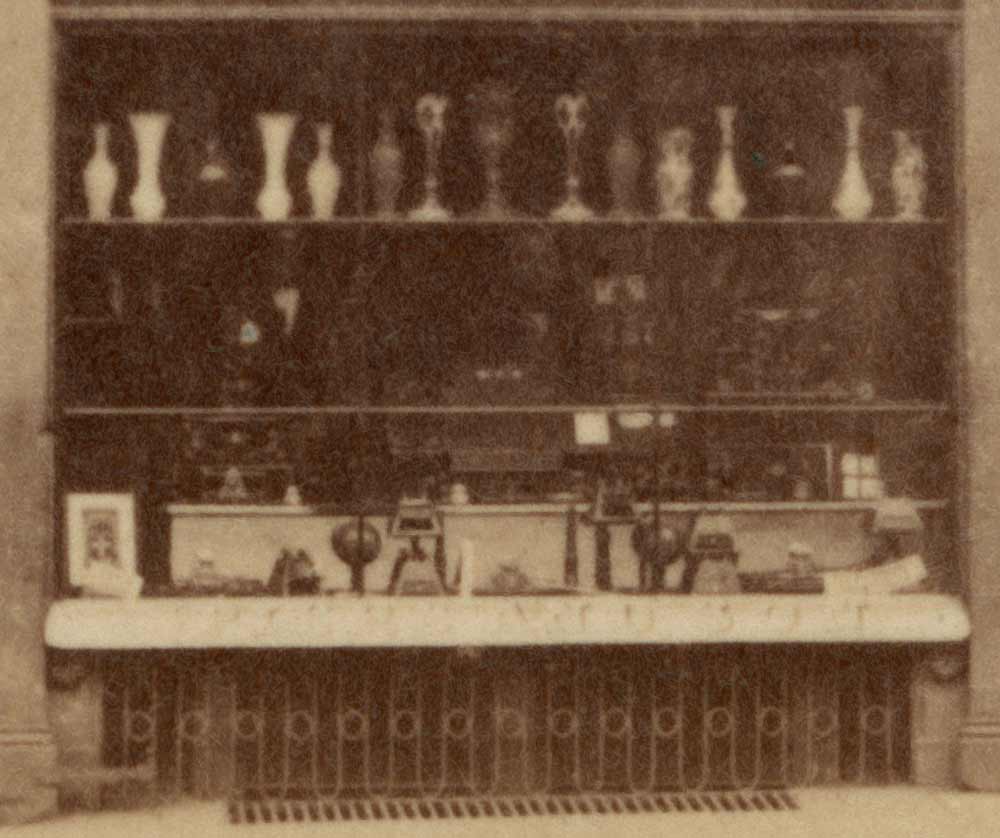
Just over a month after the publication of the ad above, Spiers and Son were ready to launch, in time for Christmas, the first 25 views of their series Oxford in the Stereoscope.
OXFORD – IN THE STEREOSCOPE.
This day is published, by SPIERS and SON, 102 & 103, High Street, Oxford,
A Series of 25 STEREOSCOPIC SLIDES; comprising the principal objects of interest in OXFORD, taken expressly for Spiers and Son by P. H. DELAMOTTE, F.S.A., forming an excellent Memorial of the University.
Price of the whole Series, 45s; of each Slide separately, 2s. Sold also in boxes, with Stereoscopes, complete.
The trade supplied only by Spiers and Son. 4Oxford Journal, Saturday 13 December 1856, p. 1
Delamotte’s photographs were shown a few days later (17 December) at King’s College, London, at a soirée of the Photographic Society. The reviewer, after praising large views of some of the public buildings in Paris, described the collection in the following terms:
Next in order may be placed a series of 25 very admirably executed stereoscopic views of the principal colleges and halls of Oxford. In these views there is evident not merely the hand of a good photographer, but the practised eye of an artist, without which a photograph is too often the dullest and most uninteresting of subjects. These stereoscopic views are reduced copies of the remarkably fine series which was published a short time since by Mr. Delamotte. 5Morning Chronicle, Thursday 18 December 1856, p. 5, “SOIREE OF THE PHOTOGRAPHIC SOCIETY”
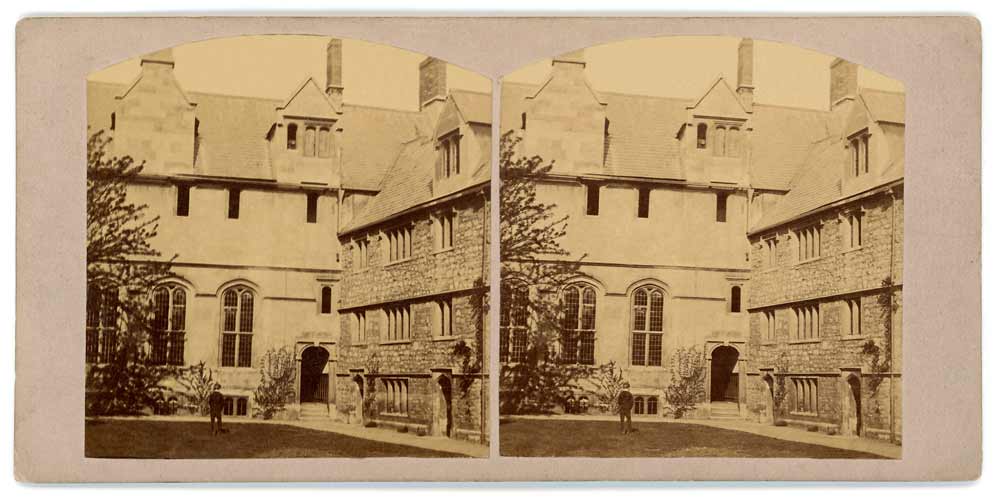
The series commissioned and published by Spiers and Son must have met with some success for six months later it was expanded to 50 views which were also duly advertised in the press. This time, Delamotte was working with his colleague from the Photographic Institution, publisher and photographer Joseph Cundall (1818-1895), as well as with “other eminent photographers” alas unnamed.
OXFORD IN THE STEREOSCOPE.
A Series of Fifty Views of its Public Buildings, its Colleges, its Gardens, and its Walks – Photographed by P. H. Delamotte, F.S.A., Joseph Cundall, and other eminent Photographers. Published by SPIERS & SON, 102 & 103, High-street, Oxford.
“The Stereoscopic Views of Oxford by Mr. Delamotte are undoubtedly the prettiest thing of the kind ever done.” – Illustrated London News.
“A Series of Stereoscopic Views of Oxford (Spiers and Son), taken by P. H. Delamotte, of King’s College, have brought vividly before us the lovely and revered spots of that picturesque city – Wolsey’s graceful tower, Wykeman’s beautiful chapel. St. Mary’s elegant spire and crumbling Jacobin porch, the more ancient and massive Cathedral pile; the Isis with its boat and the quiet Cherwell; the gardens, cloisters, and other well-known spots, such as the gateway of the old chapel of Exeter, which has now ceased to exist, are all here before us – a memorial of happy times to privileged Oxonians.” – Guardian.
The Series is divided into two sets of 25 Views; price of each set 42s. in a case. A selection of 25 may be made from the whole set at the same price. Each view separately, 2s.
Any of the above sent carriage free on receipt of a cheque or Post Office order. A list of the subjects forwarded on application. The trade supplied by Spiers and Son. 6Jackson’s Oxford Journal, Saturday 27 June 1857, p. 1
Just under one year later, on 12 June 1858 the same newspaper announced that ten new slides had been added to the series which now numbered sixty images.
The new views comprise St. Alban Hall; Balliol College new Chapel, two views, Brasenose, two views; Christ Church west front, Tom Quadrangle, Broad Walk; St. Edmund Hall; and Exeter College new Library. 7Jackson’s Oxford Journal, Saturday 12 June 1858, p. 1
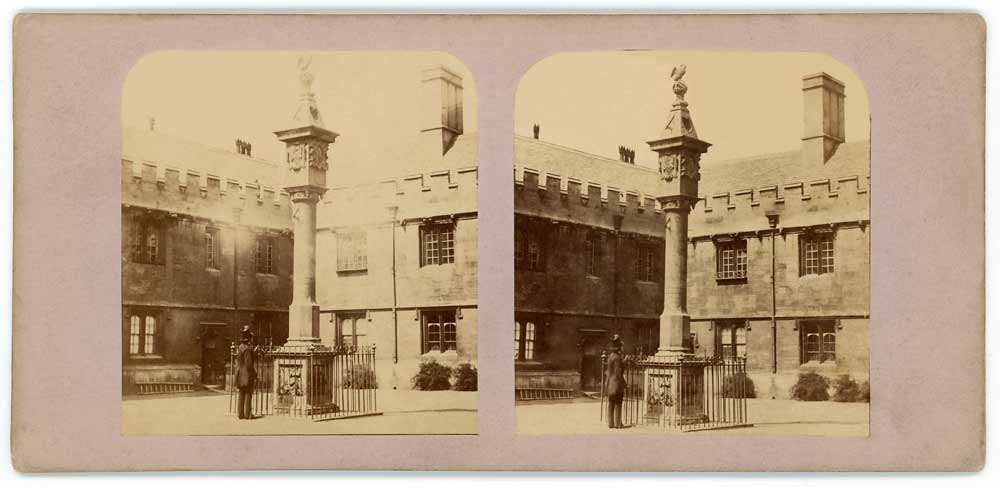
On 29 October 1858 Mrs Spiers, probably exhausted by her numerous pregnancies, died suddenly from heart disease in the bathroom of her house at 14 St. Giles. She was just over forty of age. Mr. Spiers and his surviving twelve children, some of whom were still very young, must have been devastated. But life goes on and with so many mouths to feed it had to be business as usual. On 11 December 1858 we can read in Jackson’s Oxford Journal that the series Oxford in the Stereoscope was now complete, with a total of 80 views:
SPIERS & SON
HAVE IN STOCK A GREAT VARIETY OF STEREOSCOPES, of every description, including prismatic, cosmoramic, folding, waistcoat pocket and others. Their Stock of SLIDES is very extensive, and comprises various new groups, colored and plain, flowers, statuary, views of English, Scotch, French, Pyrenean, Alpine, Italian, Spanish, and other scenery, on card-board and glass, as well as the Illuminated Transparent Slides.
OXFORD IN THE STEREOSCOPE, published by them in a series of 80 views, photographed expressly for them by Delamotte, Cundall, Howlett, and other celebrated Artists, includes subjects from the colleges, public buildings, gardens, walks, and river scenery. A list sent on application.
The trade supplied.
Orders by post promptly attended to.
Oxford: 102 and 103, High-street. 8Jackson’s Oxford Journal, Saturday 11 December 1858, p. 1
You will have noticed that despite some “celebrated Artists” remaining anonymous, a new name has been added to the list of photographers responsible for taking the stereoscopic views of Oxford; that of Robert Howlett (1831-1858). Howlett, like Cundall and Delamotte, was working at the Photographic Institution, 168 New Bond Street, London. He started making photographs in 1852 and is mostly remembered for his iconic 1857 portrait of Isambard Kingdom Brunel standing in front of the launching chains of the Great Eastern. He took a stereoscopic portrait of Britain’s most famous engineer as well as stereoscopic views of his last creation, the Leviathan. He died of a mixture of overwork, typhoid fever and exposure to chemicals on 2 December 1858 at the age of twenty-eight.
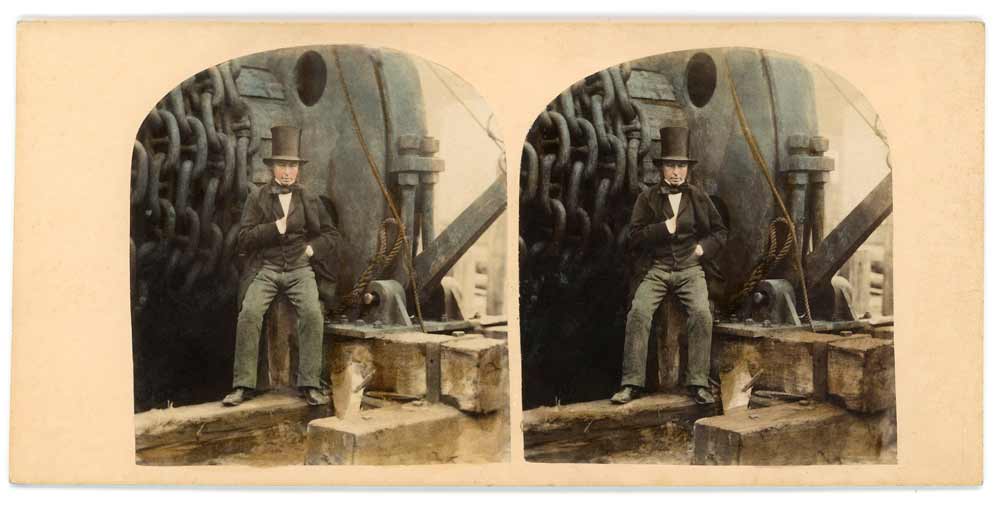
The series of Oxford in the Stereoscope, now complete, continued being advertised in the press in 1859 and 1860. That year a new advert appeared on the same day in the Oxford Chronicle and Reading Gazette and Jackson’s Oxford Journal which gives us another important piece of information about the authors of the images:
STEREOSCOPIC SLIDES,
At SPIERS AND SON’S
102 and 103 HIGH STREET, OXFORD.
OXFORD IN THE THE STEREOSCOPE; a series of Views photographed by Delamotte, Cundall, Roger Fenton, Howlett, and other celebrated Artists. […] 9Oxford Chronicle and Reading Gazette, Saturday 30 June 1860, p. 1 and Jackson’s Oxford Journal, Saturday 30 June 1860, p. 8
It is difficult to understand why the name of Roger Fenton (1819-1869) was added to the list of contributors to the series so late in the day, nearly two years after it was completed. Fenton, who had become famous nearly overnight in 1855 with the pictures he had brought back from the Crimean war was a very early experimenter in stereoscopic photography. The Wheatstone collection at King’s College London has several large binocular pairs by him that were made for Wheatstone’s reflecting stereoscope as early as 1852. There are, among them, photographs of a dead stag, of the Isle of Wight and of a trip he took to Russia. Fenton also took stereos of the rooms and exhibits of the British Museum, some of which were published in Lovell Reeve’s monthly Stereoscopic Magazine.
If we know for certain that most of the first twenty-five images of the Oxford in the Steeoscope series were taken by Delamotte it is, however, more difficult to determine which of the remaining photographs are by Cundall, Howlett, Fenton, or by any of the other “celebrated” or “eminent” photographers mentioned in the advertisements. In the case of Fenton, we have some clues since a few of the photos he took for Spiers and Son bear his blind stamp. There are two of those in Dr. May’s collection which enable us to state that numbers 21 and 44 are likely to be by Roger Fenton, although the first 25 images are generally attributed, in the press of the time, to Delamotte.
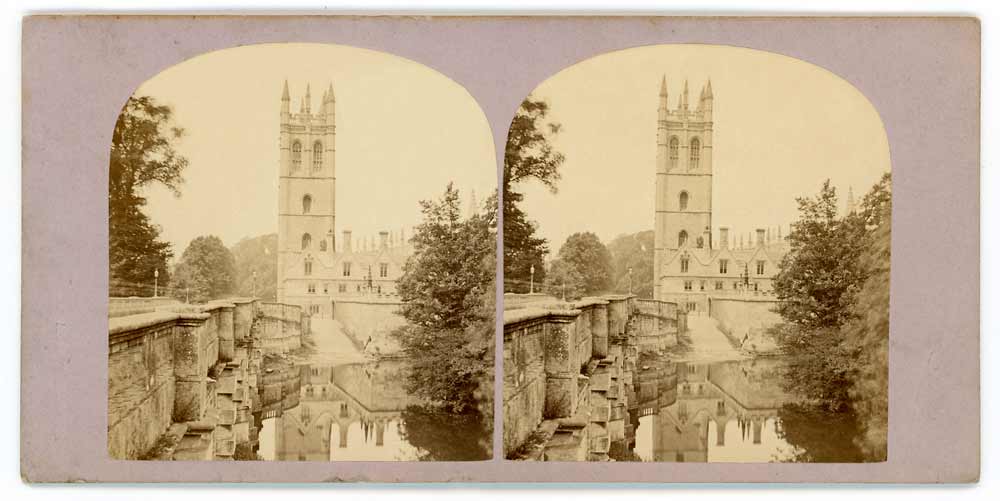
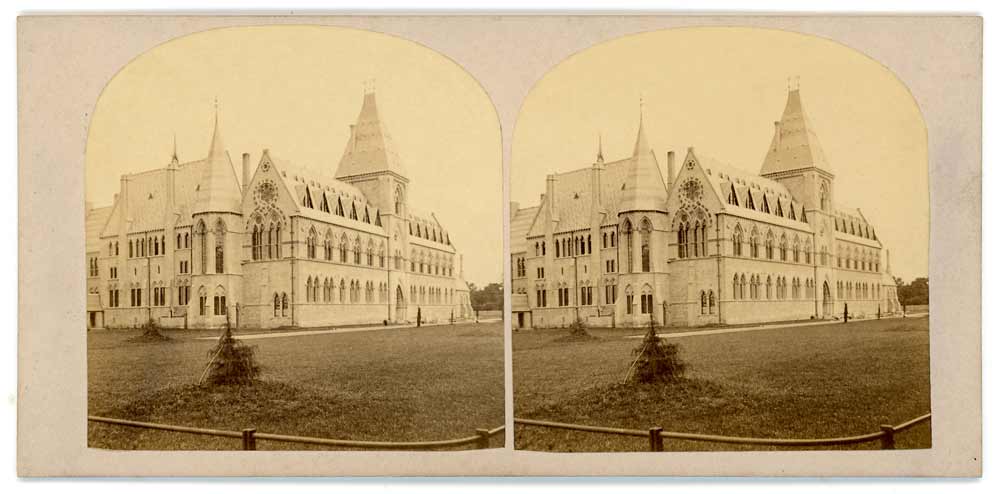
Spiers and Son’s stereoscopic views of Oford, interesting as they are as a large series are not the only stereoscopic images of the city that were available at the time. Samuel Poulton, Alfred Richard Mowbray and Henry Taunt, to name but the main ones, also published stereos of Oxford. Mowbray, for instance, published 60 views of the city of spires.
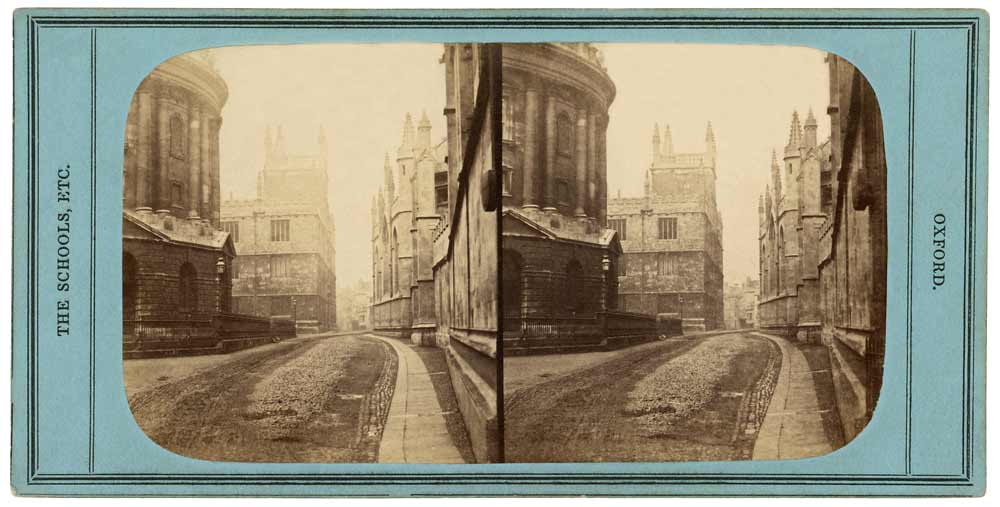
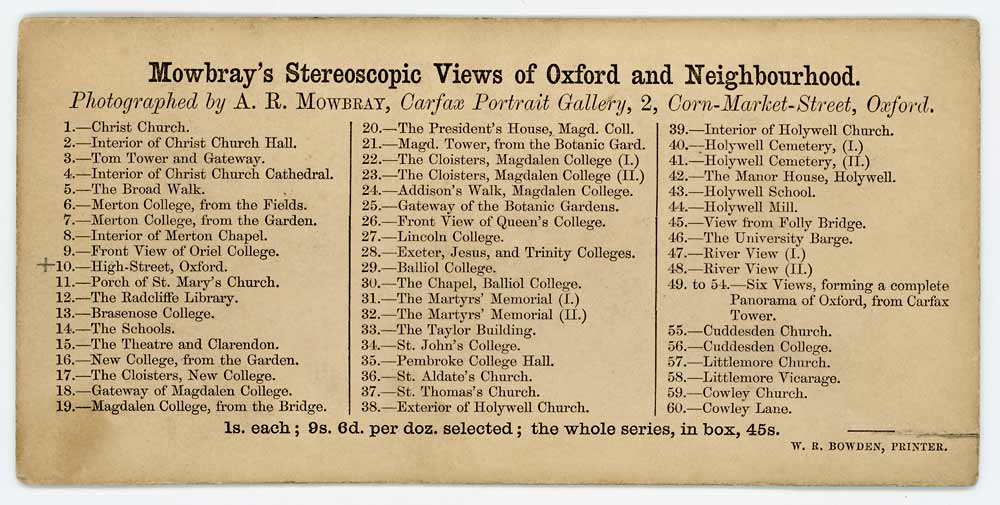
What makes Spiers and Son’s Oxford in the Stereoscope so unique for the photo historian is that the original negatives used to print the cards have nearly all survived and that there were at least twice as many images taken than were published. It is a real photographic treasure! I can never forget the time I was first shown the box containing the wet collodion plates. I couldn’t believe my eyes. Most of the negatives were square and featured two binocular images one above the other; more remarkably still, they could actually be viewed in 3-D in a stereoscope, something which is usually impossible since you normally have to transpose the left and right images before you can use a stereoscope. Could they be inter-negatives, created from the original plates and transposed to make the printing process easier ?
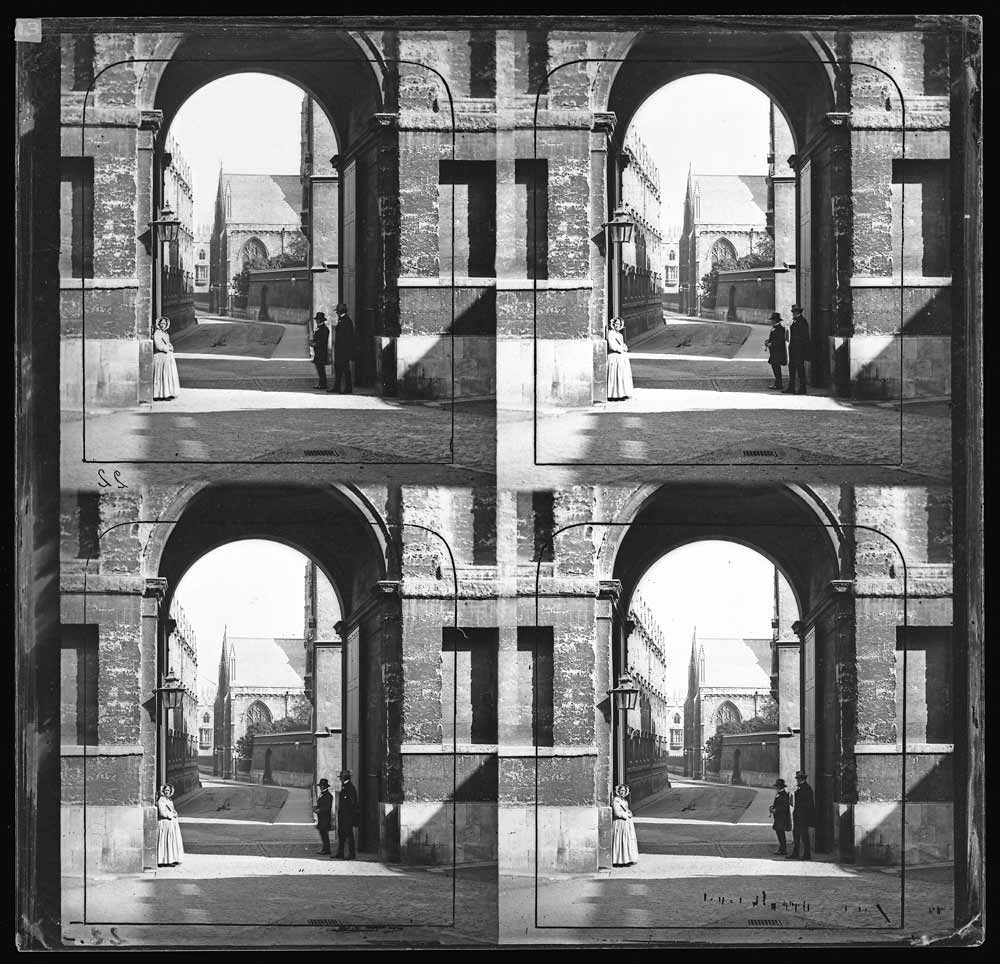
A closer look at the plates revealed firstly that some areas between the two halves overlapped in the centre which meant these were original not inter negatives, secondly that people, carts, etc., had moved between the left and right images, and thirdly that when the negatives were turned 90º to the left or to the right I could see inverted vertical 3-D !
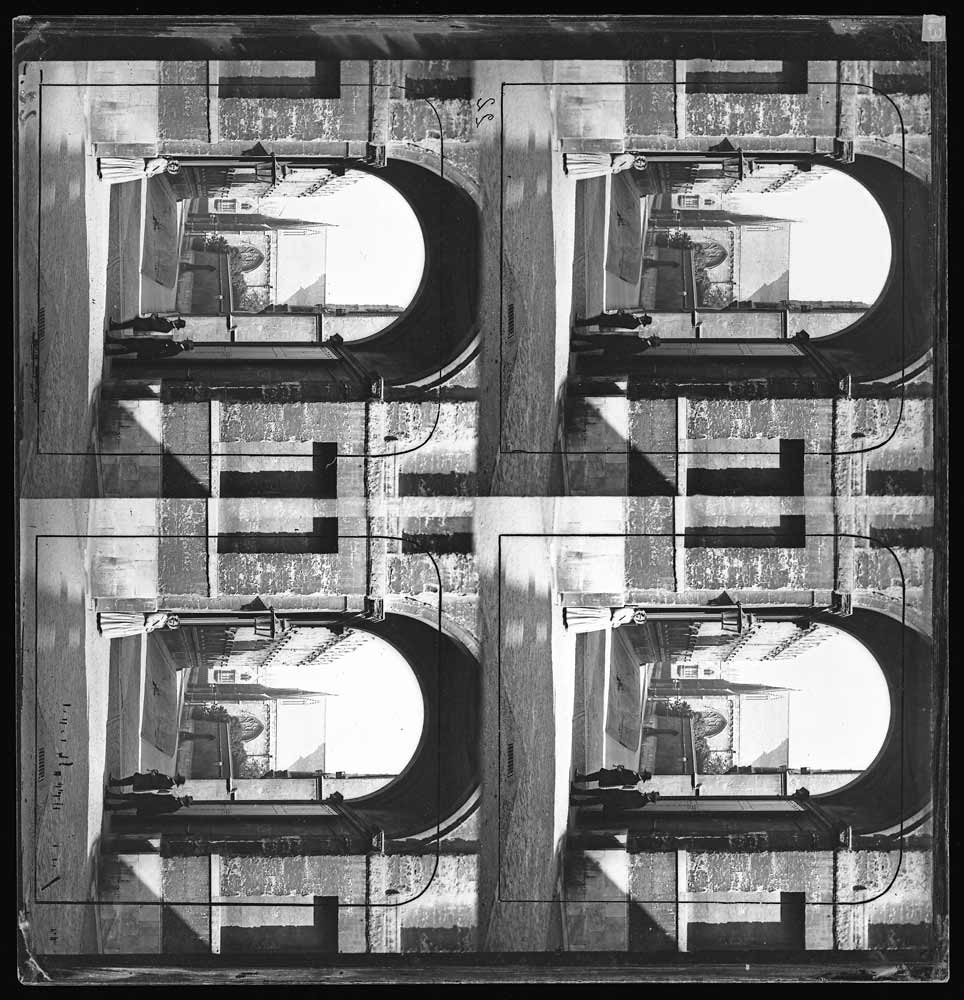
It was easy to explain the changes between the right and left images: the photographer(s) had taken the pictures sequentially, one after the other. It was common practive at the beginning of stereo photography when most artists used a single camera. It was only gradually that binocular cameras were introduced which allowed the two halves of the stereoscopic picture to be obtained simultaneously.
It took me longer to solve points 1 and 3 but I suddenly remembered reading in Dr. Brian May’s and Elena’s Vidal book A Village Lost and Found, about the stereoscopic series devoted to the village of Hinton Waldrist, Oxfordshire, by Thomas Richard Williams (1824-1871), that they had found evidence his photos had been taken sequentially with a vertical camera and that when viewed sideways it was possible to see vertical 3-D. That is, if you were lucky enough to get copies made from the bottom and top binocular images. I quickly leafed through my copy of the book and found examples that looked very much like what I had seen at Oxford.
That was point 3 solved but how about point 1 ? How could these images be the actual negatives and be viewed in a stereoscope ? The answer held in three words: Latimer Clark system !
On 5 May 1853, the newly created Photographic Society held its fourth meeting, Sir William J. Newton, the Vice-President, being in the Chair. That very day Josiah Latimer Clark (1822-1898), an electrical engineer, member of the said Society, exhibited a camera and read a paper entitled “On an Arrangement for taking Stereoscopic Pictures with a single Camera” which began thus (the bold words are my addition) :
In introducing this arrangement to the notice of the Society, I do not wish to represent it as calculated to supersede the ordinary method of taking stereoscopic pictures, viz: with two cameras, or even as being so good as that method; but it possesses a few important advantages; the pictures are produced on one plate and by one operation, with no more trouble than an ordinary portrait, and being both formed by the same lens and developed by the same solutions, they are almost sure to possess uniformity of size, tone, and intensity. Many amateurs, too, already possessing one good lens and camera, will be glad to obtain stereoscopic portraits without incurring the expense and encumbrance of two others; lastly, they require no after-adjustment of position for the stereoscope. 10The Journal of the Photographic Society. No. 5. May 21, 1853, p. 57
In what soon came to be known as the Latimer Clark system or process, the pictures are sequential, produced on a single plate, and most importantly “require no after-adjustment of position for the stereoscope”, namely, they do not need to be transposed, which fitted exactly the plates by Delamotte et al in the collection of the Weston Library. Understanding the process was one thing, proving that it worked was another and took a little longer. The main problem, obviously, was to understand how the transposition took place. Latimer Clark, fortunately explains it all in his paper. He starts by describing an ingenious system allowing the camera to move from one position to another without losing its focus. Seen from the top it looks very much like lazy tongs. Practically it makes the camera move along an arc without losing its distance to the subject and also automatically providing the right baseline or separation between the two positions of the lens. The Latimer Clark’s process also requires the camera to be equipped with a plate holder that can be moved laterally left of right. Here is how it goes:
The operation of taking a portrait is therefore thus performed. The focus having been adjusted for both positions, and the camera and the slide both drawn to the left hand, the door is raised and the plate exposed — say, for five seconds — by one motion of the hand; the camera is then shifted to the right hand, the slide moving at the same time spontaneously: this occupies less than a second of time; and the plate in its new position having been exposed five seconds longer, the door is closed, and the operation completed — the whole sitting having been supposed to occupy eleven seconds.
The portraits thus taken may be either viewed as positives upon the glass, in which manner they form very pleasing portraits, or they may be transferred to paper; or, lastly, they may be transferred to another collodion plate, by direct superposition and exposure to daylight or gas-light; by this means a positive picture is obtained, which may be either viewed as a transparency, or backed with white varnish. The effect of this is good, and deserves greater attention than it has hitherto received. 11Ibid., p. 58
When you read these lines the process sounds straightforward enough but I wanted more. I simply needed to physically prove that it worked. I looked online to try and find vintage cameras that could be bought and were in good enough condition to be actually used. Not an easy task, as most of the cameras from the early 1850s which have survived to this day – and there are not many of them – are in museums or in private collections and are often too fragile to be taken out of their display case. Fortunately, one glorious day at the London Photographica fair I found an 1850s sliding box camera which had been designed to take stereo photographs according to the Latimer Clark system. To make things even better, it came with four original stereoscopic plate holders and was in good enough condition to be made to take photos again. Needless to say that it was soon added to Dr. Brian May’s collection.
Our talented in-house carpenter-joiner, always up to a challenge, copied one of the moving boards described by Latimer Clark and having screwed the camera on top of it, we were ready to take our first stereo following the genius engineer’s detailed instructions. The subject was a plaster bust of Charles Wheatstone, the inventor of stereoscopy (it had to be) and the test was done with direct positive paper so that the image could be immediately tested in a viewer. The whole operation was filmed then photographed in 3-D and ordered photos from this sequence can be seen below.
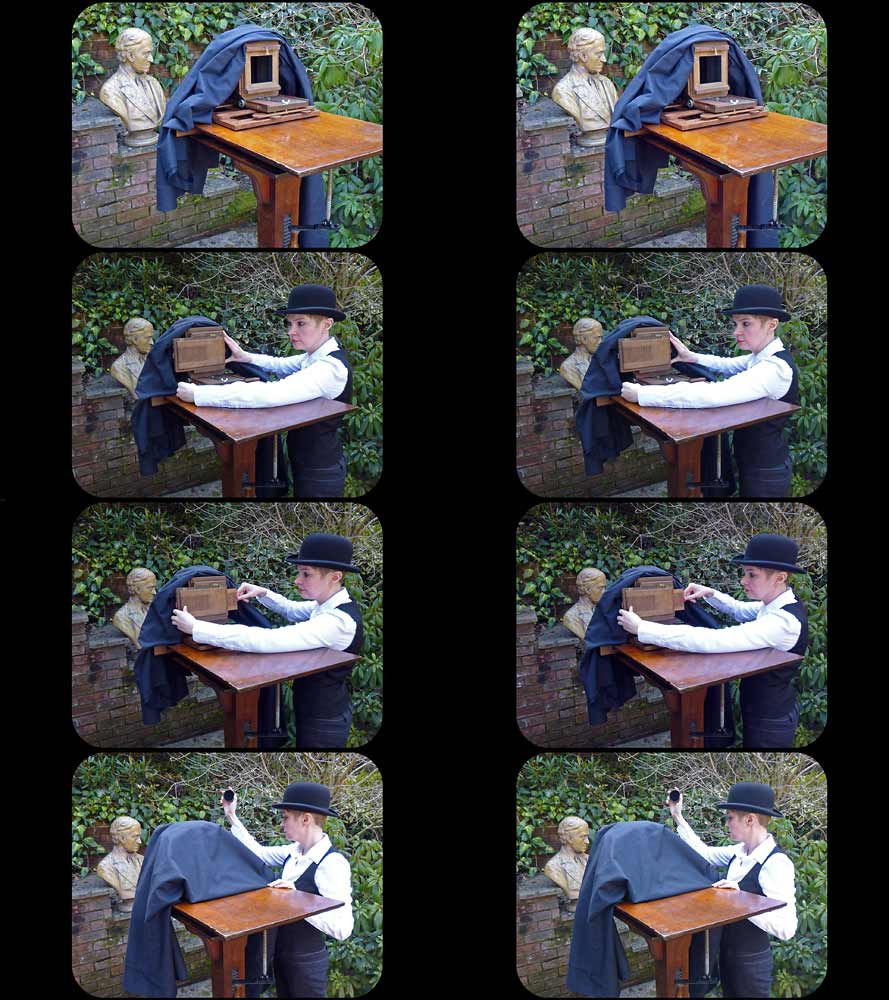

And here is the resulting image, after being developed, fixed, washed and dried, straight from the plate holder. As you can see for yourself, it works pretty well.
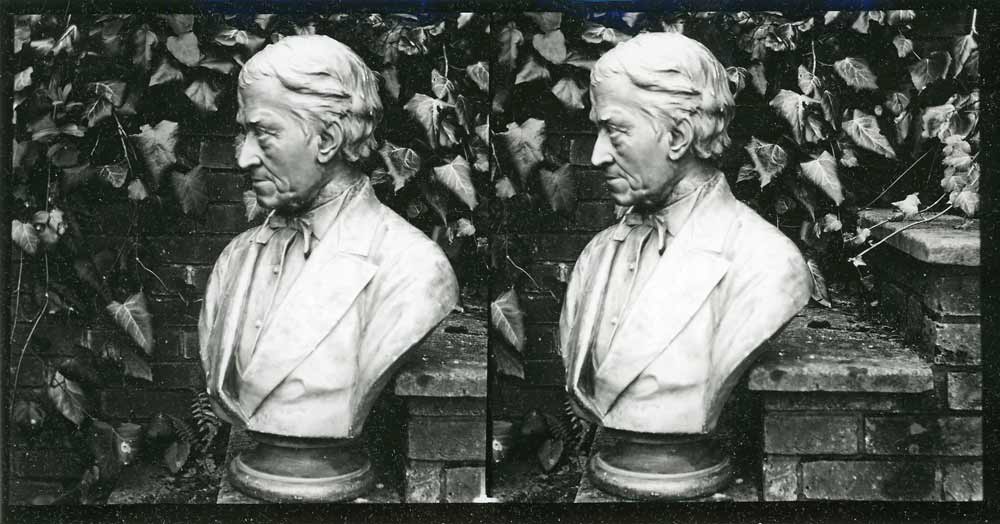
Once you get familiar with the Latimer Clark process you soon realise that quite a few photographers used it: Thomas Richard Williams, is a good example, but there are others. Half of the little-known stereoscopic photos by Lady Clementina Hawarden, for instance, were done this way too, before she bought a binocular camera.
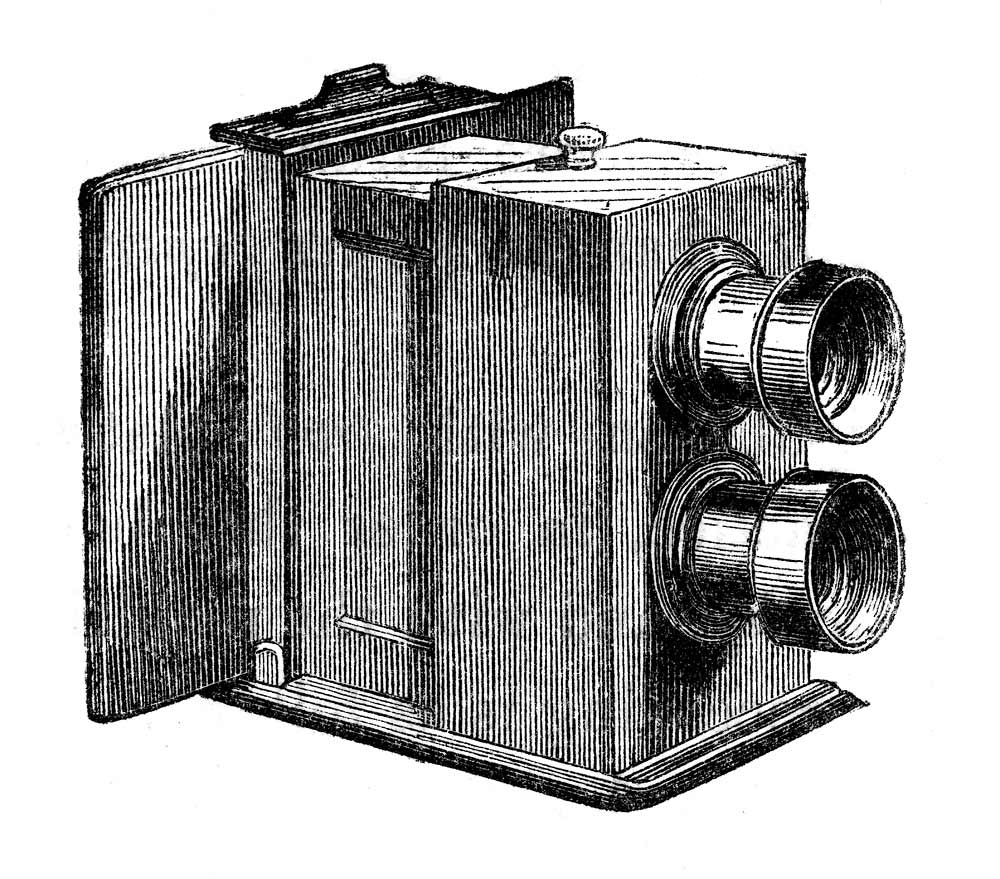
The majority of the photos given to the Weston Library by Walter Lewis Spiers were made with the Latimer Clark system but the camera used by Delamotte had two lenses one above the other. Exactly like the one engraved in an 1858 treatise on Photography by another famous stereo photographer, William Lake Price. Unfortunately for us, although he mentions he has used such a camera Lake Price does not name the maker or the camera brand.
It may seem strange, if you have two lenses one above the other, not to lay the camera on its side and use it as a binocular one in order to simultaneously take the two images necessary for the recreation of the illusion of depth. It did not seem odd to our Victorian predecessors who had a notion of time different to ours. What it means practically is that the camera did not only capture Depth but also Time. Even though the whole process did not last more than 20 to 30 seconds, a lot of things could happen in that short period and the negatives in the Weston Library collection are witness to that. Take the following for instance:

The photographer obviously asked the group in the foreground to freeze long enough for the two exposures to be made. But he could not control the man on the right from coming out of his door and staying on to enjoy the free spectacle that was given him nor stop the horse-drawn cart in the background from moving on. Neither could he stop the clouds from masking the sun during one of his exposures. Shadows are clearly visible on the left-hand half but absent from the right-hand one. These differences in the two halves of the image can sometimes be too extreme and quite distracting but the Victorians did not seem to mind. A rather funny example of this can be found in view number 31. It is called Oxford in the long vacation; from Tom Gate, Christ Church, Oxford, and shows a group of five men and a youngster. Hold on a second: is it five or six men ? Well it is five on the right but six on the left. We know the right hand half to be the first photo taken (in the previous example the cart is further away on the right) and the left-hand one the second. The photographer had told everyone to stand still, taken the first photo, moved the plate holder to the right, taken the cap off his lid and had started counting when the man in the background appeared in the frame. It was too late to do anything and the photo was printed as it was taken. We can tell this early photo-bomber did not stay for the whole duration of the second exposure as we can sort of see through his legs. In the original negative he appears on both the top and bottom left halves but not on the right ones
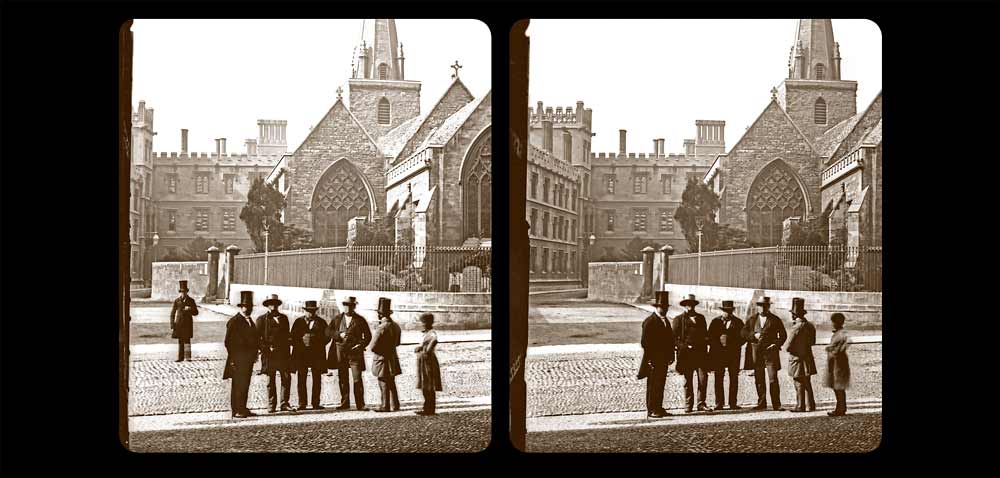
There are quite a few cases in the Spiers and Son series when things change but on the whole the photographers were careful to make sure they only had a couple of people they could control in the frame of their camera. Our Victorian ancestors, more used to standing still than we are in this day and age of perpetual agitation played their part very well on the whole – children included – and left us with very nice images as you will see for yourselves with the following gallery. It is impossible to include all the images so I am afraid it will have to be a selection. Don’t let that prevent you from enjoying these, the work of Delamotte, Howlett, Cundall, Fenton, and other eminent artists, with some help from Mr. Josiah Latimer Clark!
